Reviews of "Everything Went Fine," "Film, the Living Record of Our Memory" and "Fathers and Mothers" are all in the latest Movies with Meaning post on the web site of The Good Media Network, available by clicking here.
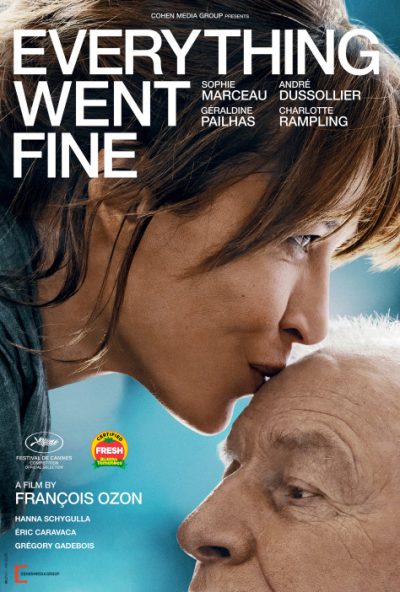
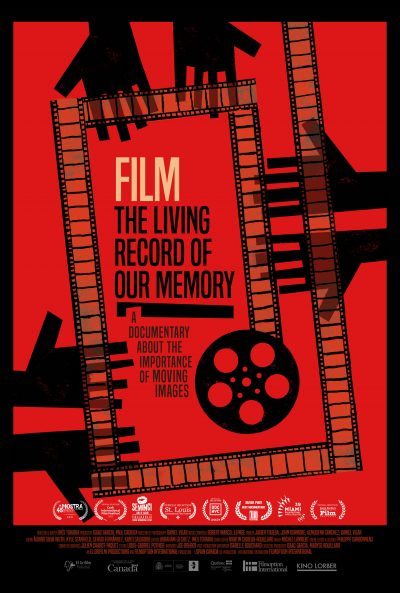


Reviews of "Everything Went Fine," "Film, the Living Record of Our Memory" and "Fathers and Mothers" are all in the latest Movies with Meaning post on the web site of The Good Media Network, available by clicking here.




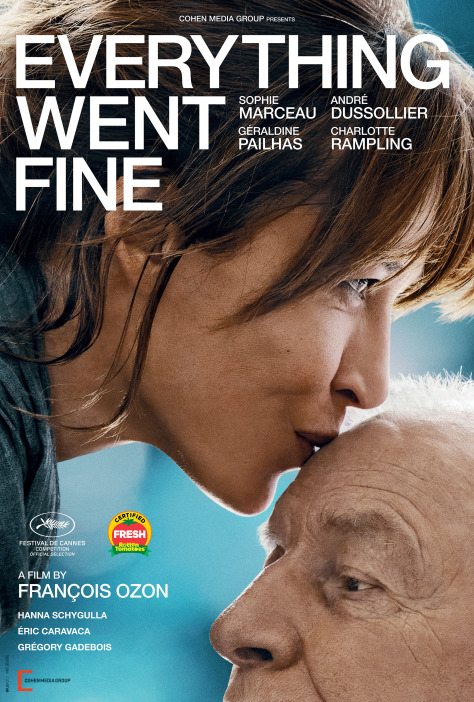
“Everything Went Fine” (“Tout s’est bien passé”) (2021 production, 2023 release). Cast: Sophie Marceau, André Dussellier, Géraldine Pailhas, Charlotte Rampling, Éric Caravaca, Hanna Schygulla, Grégory Gadebois, Judith Magre, Jacques Nolot, Daniel Mesguich, Nathalie Richard, Annie Mercier, Catherine Chevallier, Quentin Redt-Zimmer, Alexia Chicot, Madeleine Nosal Romane, Karim Melayah, Aymen Saidi, Toudo Cissokho. Director: François Ozon. Screenplay: Eammanuèle Bernheim, François Ozon and Philippe Piazzo. Web site. Trailer.
André’s caregivers freely acknowledge that he’s experienced quite a setback. But, despite the seriousness of his condition and the real possibility of further decline, they’re also surprisingly optimistic for recovery, at least to a certain degree. His life may not be what it once was, but his physicians are hopeful that he’ll be able to get back some of what he’s lost, news that raises the spirits of his daughters. However, André quietly has his doubts, despite some encouraging progress.

As someone who’s always been accustomed to getting his way (and not having had anyone in his life who would dare challenge his wishes), André expects the same now, despite his infirmity. But, when the stubborn, strong-willed, single-minded curmudgeon realizes that he won’t be all he once was, he decides he wants to bring his life to an end. He also understands that he can’t accomplish that himself, so he turns to someone for help – Emmanuèle.
Despite the harsh treatment she’s experienced in her relationship with her father, Emmanuèle loves him, though this request throws her an unexpected curve. She wants to do right by him, though she has serious reservations about whether she can comply with his wishes. And, when she makes those doubts clear, André becomes his old demanding self, insisting that she follow through on his dictates.
Emmanuèle is unsure how to proceed. She consults Pascale, who is strongly opposed to the idea. She strongly encourages her sister to dissuade him about the notion, but that argument comes easier for Pascale, given that she apparently never suffered the same degree of parental abuse that her sibling experienced. And, to her credit, Emmanuèle admits that she won’t proceed with the plan unless she has Pascale’s agreement. However, given her love for André and her reluctance to decline his request, she does her best to try and win over her sister’s concurrence, a decision made more difficult in light of her father’s steady recuperation. But André’s mind is mind up, despite whatever progress he’s made – he wants out, and the sooner the better.
Having secured Pascale’s begrudging consent, Emmanuèle begins looking into what an assisted suicide would entail. Given that such practices are illegal in France, Emmanuèle quickly realizes that, if the procedure is to be carried out, she and André will need to arrange for it to be conducted elsewhere, the nearest potential venue being in neighboring Switzerland. She contacts a Swiss organization that helps to arrange such procedures and agrees to meet with one of its representatives in Paris.

Considering the sensitive nature of this venture, virtually every aspect of it is handled clandestinely to prevent word from getting out to French authorities prepared to step in and stop it, even if the procedure is to be conducted out of the country. Indeed, in making the arrangements for it, even the name of the organization’s representative is kept secret; in all her dealings with Emmanuèle, she discreetly goes by the ambiguous code name “the Swiss lady” (Hanna Schygulla).
When Emmanuèle and Pascale meet with their Swiss contact, they discuss the details, which turn out to be quite specific, detailed and extensive. For example, in order for the organization to be able to legitimately assist the family, André must demonstrate that his medical status is truly dire (with medical records to verify his condition) and that he’s not an individual who’s depressed and simply trying to do himself in, particularly if he’s showing signs of improving health. He must also demonstratively signal and document his sincere desire to bring his life to an end. There’s a mountain of paperwork to be completed in connection with all this, as well as a carefully orchestrated series of logistical considerations that must be arranged to transport the patient from Paris to Bern, where the procedure will be conducted. And, of course, there’s the high cost involved, but, given André’s ample financial resources, this, fortunately, is not a problem for him and his family.
Even though André would like to get this over with as quickly as possible, the time involved is longer than he would like. And, given his growing inability to keep secrets, he invariably says more than he should about what’s in the works, leaving him and his daughters potentially exposed to the prying eyes of French authorities, as well as the potential liability that could be involved. Clearly this is an undertaking that’s more complicated than the family anticipated.
But the legal arrangements are just one part of the stresses involved. There’s also the emotional turmoil to contend with. It’s not so much an issue for André as it is for his daughters, as well as the patriarch’s grandchildren, Raphael (Quentin Redt-Zimmer) and Noémie (Alexia Chicot). Through all this, however, the greatest burden is placed on Emmanuèle. She’s torn between carrying out her father’s final wishes and dealing with her own opinions on the subject. She’s also aware that time is running out to reconcile her feelings about André, both in terms of her love for him and the hurt she experienced during her childhood. What’s more, she’s also having to contend with the failing health of her mother (Charlotte Rampling), a Parkinson’s patient who has been in a state of decline for some time, particularly after her divorce from her husband. It’s quite a full plate on top of everything else.
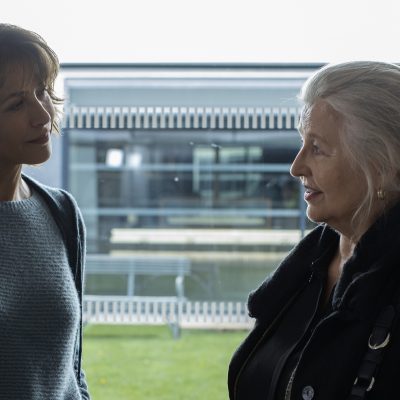
As the story plays out and the proposed deadline approaches, it remains uncertain whether events will unfold as projected given the legal requirements, logistical arrangements and emotional considerations involved. There’s even the possibility, as the Swiss lady observes, that the patient might change his mind as the time approaches, as sometimes happens in cases like these. And, of course, there’s always the possibility that word of the impending events will reach authorities before the story concludes. How will it end? That remains to be seen.
In making her decision, Emmanuèle needs to look within, to examine her beliefs, for not only will they help her make a choice, but they will also help to determine how events unfold. That’s what happens with the conscious creation process, the philosophy that maintains we draw upon these intangible resources in manifesting the reality we experience. Emmanuèle may not have heard of this school of thought, but she’ll need it to get through the upcoming ordeal and, one would hope, to reach a satisfactory conclusion.
Considering the complexity of this situation, Emmanuèle clearly has a bundle of beliefs to sort out. To begin with, she needs to examine her feelings about the prospect of assisted suicide in principle and how it applies to her own family’s circumstances. Then she has to sort out her beliefs about her relationship with André – both sides of the love/hate equation she has where he’s concerned, as well as how willing she is to comply with his wishes. She also has to take into account Pascale’s feelings, seeing as how she stated that she would not proceed with this venture without her agreement. And then, of course, there’s the decision itself, which combines all of the foregoing considerations. Just talking about all of these concerns would seem to render this an almost impossible decision to make.
In reaching a determination, Emmanuèle needs to employ her power of discernment to make a decision. She needs to go through all of the foregoing beliefs and prioritize them. This calls for a precise weighting and delicate balancing of all of the pertinent considerations, a sorting process that, regrettably, may be anything but easy. But, given the emotionally charged conditions involved here, it’s a necessary step that she must take.
In particular, Emmanuèle must seek to allay any fears that might be getting in the way, as they’ll hold her back in reaching the necessary determination. She must consider, for example, whatever anguish might be associated with the process of attempting to balance her personal opposition to assisted suicide against the pain of letting down her father by denying him his final wish. How does she reconcile such considerations? That’s what she needs to figure out, using her beliefs to do so. And fears, like all of the other concerns involved, are another form of belief to be dealt with.

Movies about assisted suicide and the right to die have made their way into the cinematic lexicon over the years, and many of them have given just treatment to the subject, as evidenced by such titles as “Blackbird” (2018), “You Don’t Know Jack” (2010), “Whose Life Is It Anyway?” (1981) and “The Barbarian Invasions” (2003). And now writer-director François Ozon’s latest feature outing can be added to that list. This fact-based drama capably and comprehensively examines this topic from a variety of angles, and it does so with a great deal of integrity, authenticity and heartfelt feeling. It’s also one of the finest, most accessible offerings from a filmmaker whose works I usually believe leave much to be desired. However, the filmmaker has come through admirably here with material that could be easily mishandled if left in the hands of a less skilled director. With that said, however, that’s not to suggest that this release is without its issues, such as several story threads that don’t feel fully resolved, along with some occasionally strange camera work and seemingly superfluous narrative elements. Nevertheless, “Everything Went Fine” has much in its favor, including excellent performances by its three principals (Marceau, Dussellier and Pailhas), an inclusive script, sustained pacing, well-placed moments of comic relief, and genuine emotional impact without becoming manipulative or schmaltzy. If you can look past this offering’s minor shortcomings, you’ll come away from it having had a moving and insightful cinema experience, as well as a thoughtful meditation on when it’s time to stay and when to go. The film is available for streaming online.
Copyright © 2023, by Brent Marchant. All rights reserved.
Join yours truly and show host Frankie Picasso for looks at five new films on this month’s second movie review edition of the Frankiesense & More video podcast! The show, to begin airing Thursday May 25 at 1 pm ET, will examine two new foreign offerings and three new compelling documentaries. Tune in on Facebook or YouTube for all the fun and lively discussion!
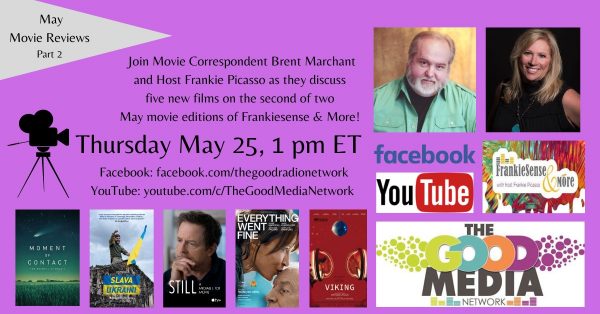
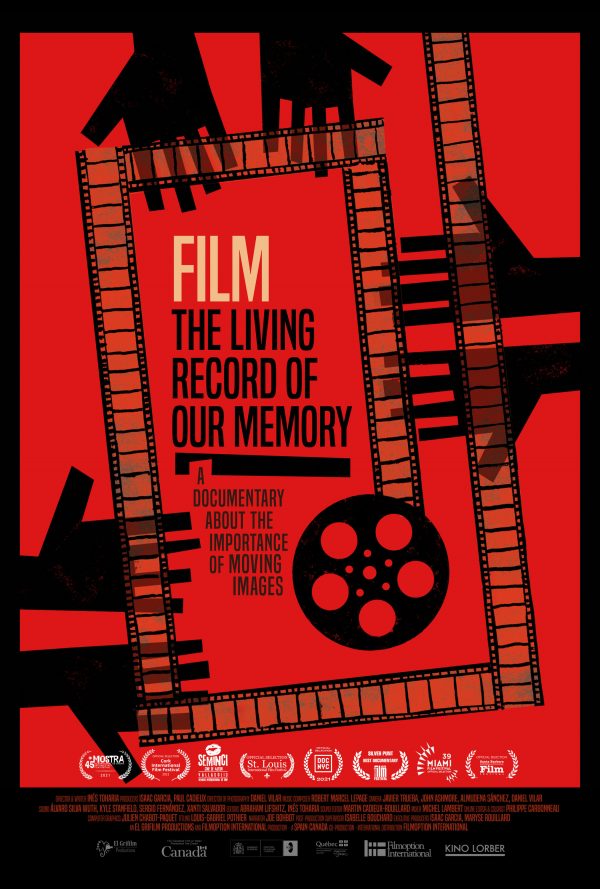
“Film, the Living Record of Our Memory” (2021 production, 2023 release). Cast: Interviews: Ken Loach, Costa-Gavras, Wim Wenders, Ridley Scott, Jonas Mekas, Patricio Guzmán, Margaret Bodde, Joseph Bohbat (narrator). Archive Footage: Martin Scorsese, George Lucas, Steven Spielberg, Sydney Pollack, George Romero, Ben Mankiewicz. Director: Inés Toharia Terán. Writer: Inés Toharia Terán. Web site. Trailer.
Imagine if there were no “Casablanca” (1942). No “Jaws” (1975). No “2001: A Space Odyssey” (1968), no “Avatar” (2009), no “Wizard of Oz” (1939). The prospect is unthinkable, even to the most casual moviegoer (imagine what that would mean for an avid cinephile). That’s what we’d face if no concerted effort were made to preserve these films for posterity. Surprisingly enough, however, this is a practice that, until recently, received far too little attention – and with devastating consequences. Fortunately, this subject has been garnering wider consideration, but it’s one about which we need to remain vigilant. That’s the message to come out of an impressive new documentary about this topic, “Film, the Living Record of Our Memory.”
Film has become so ubiquitous that we take it for granted. From big screen epics to intimate arthouse dramas to revealing documentaries to home movies, we see these cinematic records of us and our world virtually everywhere we look. It’s a phenomenon that’s present globally, too, one that spans all seven continents. And, because these images have been committed to what’s perceived to be a fixed medium, we tend to assume that these records will be with us permanently. But will they?
As writer-director Inés Toharia Terán’s compelling new documentary reveals, that’s not an assumption we should make – indeed, far from it. This excellent examination of film preservation efforts is an eye-opening revelation, showing us just how much of movie history has been lost – an estimated 80% of all silent films ever made and roughly 50% of those created since the invention of talkies. The documentary explores the reasons behind these tragedies, as well as the efforts that have been made to save and/or restore pictures that could have easily – or still might possibly – become lost without concerted initiatives to protect them.
Without being alarmist in tone, this film makes an impassioned case for the need for preservation. But that plea nonetheless raises the question of how and why these movies have become lost in the first place. And, as this documentary pointedly shows, there are a variety of reasons behind this.
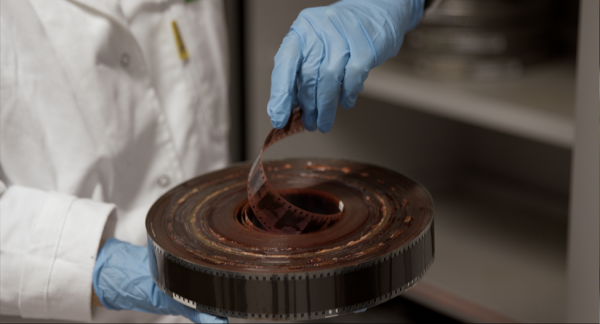
To understand this, it’s crucial to know something about how many early films were made and looked upon. In most instances, the images of these pictures were committed to something called nitrate film. It provided good image quality, but there a few important catches that came with it. For starters, nitrate film had a high silver content, and, given that, the minerals contained within it were considered more valuable than the finished works it captured. In large part, that’s because movies were seen as a novelty (and an easily disposable one at that), not as the legitimate art form they’re considered today. Many pioneering filmmakers and distributors believed that their movies had little residual value beyond the revenue they generated from their initial release. After all, they assumed, who would want to watch something they’ve already seen?
Because of that, many reels of nitrate film were recycled after the movies they contained had had their premiere runs at neighborhood nickelodeons. The silver in the film was retrieved and employed in what were considered better, more practical uses. The reclamation of this precious metal thus became a lucrative incentive for filmmakers and distributors strapped for cash.
To complicate matters, nitrate film was highly flammable. Screenings of pictures created with this technology were potentially dangerous to projectionists and, possibly, theater patrons and employees when the devices used to show them generated too much heat. This inherent pitfall led to the destruction of many films (especially during the silent era), sometimes even when simply in storage and not being run through projectors. Warehouse fires containing huge stockpiles of nitrate-based films proved devastating, both in terms of their financial and artistic losses.
When avid movie enthusiasts saw what was happening, they became concerned. But they had little initial success in generating interest in film preservation. To begin with, they had difficulty convincing potential backers for this effort that movies were a legitimate art form and not just some inconsequential passing distraction. At the same time, they also needed to convince studios and distributors that the archives they proposed to create for this purpose weren’t in competition with them. They needed to allay any fears that their intention was designed to siphon off revenue from those organizations. And, because of those roadblocks, progress at promoting preservation was slow for a very long time.
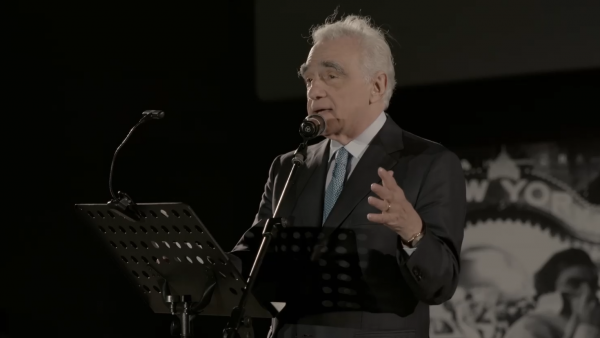
In addition to these issues, preservationists had to contend with other challenges. In many cases, the methods used for storing movies – both on nitrate film and on safer alternatives developed later – were often inadequate, leaving the materials subject to decay from ambient environmental conditions. Heat and humidity did in many offerings, especially among those stored in locations where these climatic conditions prevailed. Tropical locations often proved fatal to saving many pictures.
But deterioration was not the only culprit behind film loss. In some cases, censorship by authority figures led to the intentional destruction of movies considered subversive, as was the case in Nazi Germany and Soviet Russia, for example. In fact, many of the pictures that managed to survive those eras did so only because they were smuggled out of the country and placed in the hands of capable caretakers. Careless management in studio archives also led to the loss or destruction of many pictures whose curating was haphazard. Poor storage conditions and record-keeping led to considerable harm, issues that were often compounded when many smaller studios and distributors were sold or consolidated. And, of course, there were the aforementioned recycling programs that resulted in the willful destruction of films for their silver content.
Despite the establishment of a number of pioneering archive facilities in the US and Europe, preservation efforts made little progress until some of the movie industry’s most noteworthy productions began to be placed in jeopardy. That raised some significant red flags for industry leaders, particularly directors, who saw what the viewing public and future generations could lose if steps weren’t taken to curtail this decline. Leading the way in this effort was filmmaker Martin Scorsese, a diehard movie lover who couldn’t bear to see these works disappear. He led an aggressive campaign to promote this cause, backed by peers like Steven Spielberg, George Lucas and Sydney Pollack, along with directors from outside the US, as well as an array of technical experts and producers who wished to see their works (and their investments) preserved. This effort has since led to stepped-up efforts to further the cause before more works are irretrievably lost.

It should be noted that this is an initiative that’s not limited to the annals of Hollywood. It’s global in scope, including initiatives that have been launched in Latin America, the Caribbean, Europe, Africa and Asia. What’s more, it’s not restricted to theatrical releases. Preservation activists have also strongly encouraged the protection of personal projects, such as home movies – not by seeking to necessarily include them in formal archives but by educating amateur camera operators to consider employing some of the same protective techniques for their materials as those used to save big screen classics. These films may not be important to everyone, but they’re certainly cherished items to those who made them for themselves and their families.
This film examines some of the efforts and technology used to save these films, both from a preservation standpoint and from a restoration perspective. In many cases, these restorative programs have made it possible for contemporary viewers to see how these pictures were originally intended to be shown but were hampered by technical limitations that have since been overcome, efforts profiled through several specific cinematic case studies. Such efforts have not only kept these movies alive, but they have actually brought them to life in ways that were once thought unimaginable – and that would almost assuredly delight those who first created them.
As noted above, there are those who have erroneously assumed that commitment of images to a fixed medium guarantees their permanence, a notion that carries potentially dangerous consequences for uninformed movie lovers. And, as the film also astutely observes, this is a caution that needs to be borne in mind even when it comes to the use of more contemporary (and supposedly superior) image storage technologies. Digital preservation, for example, may offer an opportunity to forestall the inevitable decay of conventional celluloid, but are the effects ever-lasting? There’s no airtight guarantee that these new technologies ensure permanence any more than film itself. In light of that, director Terán and her interview subjects make clear that preservation is an ongoing effort, one about which we need to be vigilant if we hope to preserve these materials, lest we fall prey to the same kind of apathy and disinterest that allowed so many movies to become lost in the first place. If we truly wish to maintain these films, we have to remain diligent to see that the intent behind this effort carries through to fulfill its goal.

There are a number of good reasons for this, but one of the most basic is that making movies is a demonstrative act of creation, one whose fulfillment is the end result of a dream, a belief that these conceptual works of art can truly materialize in physical form. Such are the outcomes of the conscious creation process, the philosophy that maintains we manifest our reality and everything within it through the power of our thoughts, beliefs and intents. That notion is present in the nature of film itself – when those flickering individual images are played in sequence and exposed to a light source as they’re projected onto some kind of screen, they magically tell stories, bringing ideas that were once inherently intangible into tangible existence. Not all such stories are equally compelling to everyone, but they all have their origins in the consciousness of their creators, and their fully fledged realization means something to those who brought them into being, even if they mean little or nothing to anyone else. In short, they’re each bona fide acts of creation and deserve to be respected and preserved as valid artistic materializations.
But there’s more to it than that (even if the foregoing consideration is sufficient enough in itself). For starters, movies are rarely the creations of a single individual; they’re intricate collaborations, frequently involving many participants from the directors to the producers to the performers to all of the technical and support staff who work on the finished products. In that regard, they are truly acts of co-creation, all driven by the thoughts, beliefs and intents of those who contributed their input into these manifestations. And everyone who participates in these endeavors deserves to have his or her contributions respected and preserved, no matter what others may think about the end results.
Then there’s the nature of the content and the value it contains. This is particularly important where films of a documentary nature are concerned. Consider what might have been lost if the preserved footage of a number of historic events had been allowed to disappear. What record would there have been of the first moon walk? Likewise, what would we have known about man’s first recorded visit to Antarctica, such as the explorers’ whimsical reaction to their first awareness of the existence of penguins? Then there are events whose recordings poignantly remind us of how to keep history from repeating itself, as seen in documentary footage of the persecution of Jews in pre-World War II Europe. Even the sentimental value of family events in home movies could be lost if these materials are allowed to disintegrate; film of mom and dad’s silver wedding anniversary may not carry much weight in the history of humanity, but it certainly would mean a lot to their descendants if the footage were to vanish. Beliefs associated with the need to protect the images of events big and small should be enough in themselves to promote their preservation.

And that brings us to a significant reason for the foregoing – the emotional impact that films carry, especially when it comes to forging meaningful connections between the art and those interacting with it. As famed director Ingmar Bergman observed in a 1991 edition of Sight & Sound, “No art passes our conscience in the way film does, [going] directly to our feelings, deep down into the dark rooms of our souls.” That statement alone is perhaps one of the most insightful assessments of what movies can do for us individually and collectively, a profound capability that surpasses virtually any other art form. Indeed, when one embraces that belief and witnesses its impact in action, there’s arguably no viable contention that can otherwise counter it.
When movies are looked upon in that sense, their impact can be substantial. They serve as valuable teachers. They inspire us to conceive new ideas and explore previously uncharted territory. And they serve as a mirror of our world, showing what’s right with it and what could use improvement. But none of that might be possible if these visual records were not suitably protected and preserved.
Drawing attention to the meaningful effects that movies can have on us has been my mission for more than 15 years, as demonstrated through my three books and countless website blogs. I passionately believe in their value to inspire us in helping to write the scripts of our lives. And that’s why I also so fervently support efforts aimed at film preservation.
The loss of so many films over the years demonstrates just how delicate and precious an art form movies are. What we see as a powerful and impressive creation today could easily become a crumbling pile of rubble in short order if we don’t take steps to ensure its viability and continued existence. Thankfully, there are a growing number of curators out there who zealously believe in the value of preserving these works and the ability to come up with the means to make this possible. We all owe them a debt of gratitude for their efforts and what they’re enabling for us and for those who succeed us.
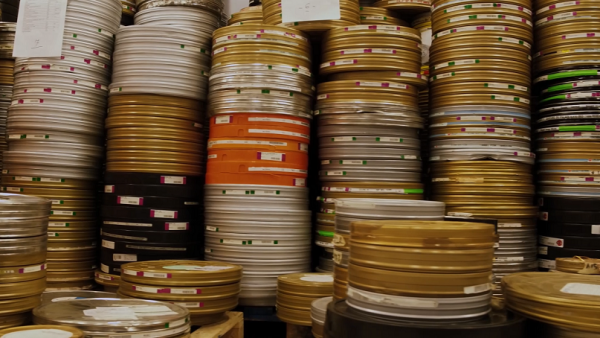
Film preservation is such a huge, multifaceted subject that it may be difficult to get one’s hands around it. However, writer-director Inés Toharia Terán has done just that in this compelling new documentary. It effectively covers a tremendous amount of ground without becoming scattered, presenting its material in a highly intelligent, well-organized manner. Terán’s work is particularly impressive from the standpoint of comprehensiveness, showing the impact that this effort has had on film collections from around the world, from all ages past and from all genres, not an easy feat given the breadth of content involved. Through interviews with leading directors, archivists, restoration professionals and photographic industry experts, viewers gain an insightful new appreciation for why these celluloid records matter to us and why it’s important to make the effort to save them from neglect before they’re gone forever. Admittedly, some may find this offering a little overlong, but, in my view, better more than less when it comes to a showcase aimed at purposely illustrating the need to preserve these precious and otherwise-irretrievable materials. And, to its credit, the film does a fine job of keeping its narrative from becoming too technical, a noteworthy accomplishment for a subject that could easily become overly burdened by indecipherable jargon. This work is must-see viewing for anyone who loves movies and passionately desires to see as many of them curated as possible, making their continued existence available to posterity as a genuine living record of our memory. The film is available for streaming online.
To ardent cinephiles, losing a movie forever is almost akin to the death of a loved one. The loss is felt personally, but, given the intimate connection this art form often forges between subject and viewer, that’s entirely understandable. We’ve made great strides in furthering this cause, but there’s always room for improvement, a vital consideration in the face of a ticking clock. This should thus serve as a powerful reminder to take action before it’s too late. But, as long as we believe in such a possibility, there’s no reason we can’t make that happen. The magic of the movies proves that virtually anything conceivable is indeed attainable. So let’s get busy and do that while we still have the chance.
Copyright © 2023, by Brent Marchant. All rights reserved.
Tune in for the latest Cinema Scribe segment on Bring Me 2 Life Radio, beginning Tuesday May 23, available by clicking here. You can also catch it later on demand on Spreaker, Spotify, Apple, iHeartRadio, Google Podcasts, Castbox, Deezer, Podchaser and Jiosaavn.

Reviews of "Viking," "Slava Ukraini" and "Still: A Michael J. Fox Movie," along with a podcast preview, are all in the latest Movies with Meaning post on the web site of The Good Media Network, available by clicking here.
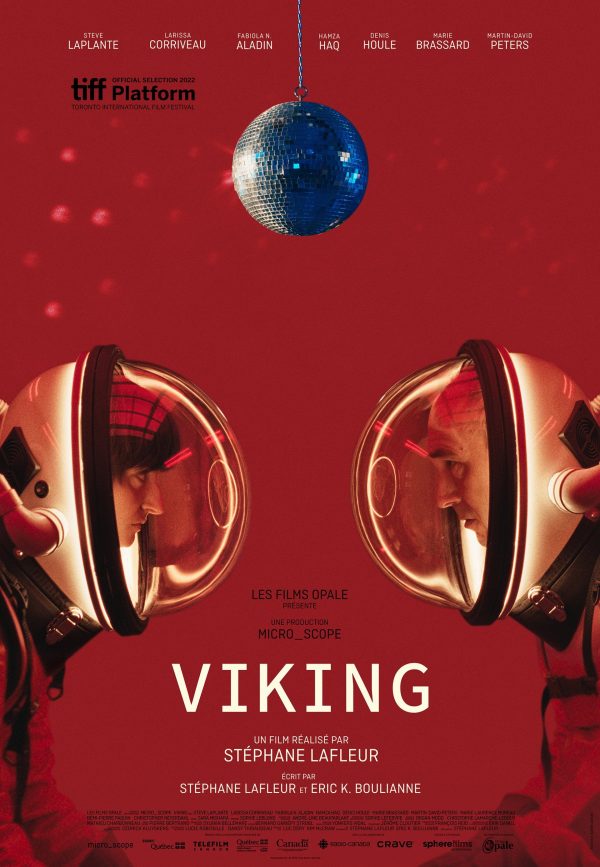

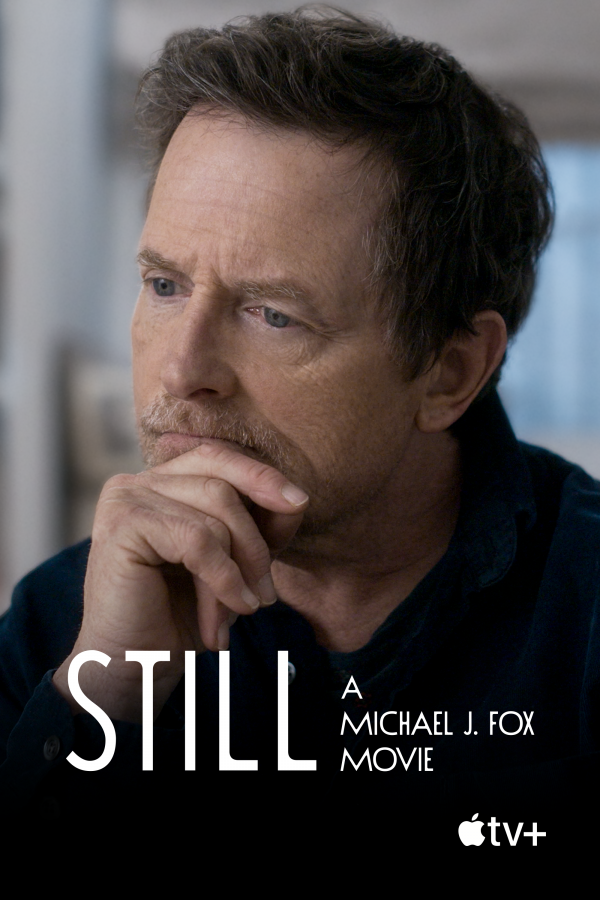



“Still: A Michael J. Fox Movie” (2023). Cast: Interviews/Contemporary Footage: Michael J. Fox, Tracy Pollan, Annabelle Fox, Aquinnah Fox, Sam Fox, Schuyler Fox, Siobhan Murphy. Re-creations: Danny Irizarry, Hannah Galway, Kai Kreinman, Miles Meacham, Sherry Klassen, Darren Zimmer. Archive Footage: Barbara Walters, Phil Donahue, Katie Couric, Roger Ebert, Gene Siskel, Muhammed Ali, Meredith Baxter, Justine Bateman, Gary David Goldberg, Brandon Tartikoff, Christopher Lloyd, Crispin Glover, Eric Stoltz, Thomas F. Wilson, Sean Penn, Barry Bostwick, Richard Kind, Jay Leno, Johnny Carson, Joan Rivers. Director: Davis Guggenheim. Source Material: Michael J. Fox. Web site. Trailer.
In short order, Fox was seemingly everywhere all at once, a fitting development for someone who had lived his life like that from the time he was a child. This frenetic pace of living had followed him for so long, in fact, that he never learned how to be, as this film’s title suggests, still. He admits that he never really took the time to stop and take stock of his life, particularly looking inward to examine who he was. And, with all of his success and the buildup he received because of it, the once-struggling actor came to believe that he could do anything, that he was virtually invincible.
In 1990, however, Fox received a medical diagnosis that nearly stopped him in his tracks – he was discovered to be suffering from Parkinson’s Disease, an illness that usually strikes in old age, not someone on his late 20s. He had difficulty accepting the news, often asking himself, “How could something like this happen to me? I’m Michael J. Fox!”

Having never learned how to be still and at peace with himself, he didn’t know what to do. His first reaction was denial, a mindset that prompted him to try to escape. He sought refuge in drinking, something that turned from a pastime into an addiction. It didn’t help the management of his illness and placed a strain on his marriage to wife, actress Tracy Pollan. And, even though he eventually succeeded in kicking the habit, he still hadn’t come to terms with his diagnosis.
Fox next sought to conceal his condition, something he did rather successfully for a number of years. He learned how to cleverly mask his Parkinson’s symptoms through a combination of medication, sustained sobriety and throwing himself into a steady work routine, returning to television in the series Spin City (1996-2001) for which he won a Prime Time Emmy Award for best lead actor in a comedy on top of three additional nominations in the same category. But, try as he might to keep things under wraps, he eventually reached a point where he felt he had to openly acknowledge his circumstances, which he did at a high-profile press conference.
With the burden of this secret removed, Fox started work on changing his life. He began focusing on his treatment, which included regimens for his physical symptoms and guidance on how to slow down, look within, and place his personal and professional lives in perspective. He also devoted more attention to his family life, spending more time with his wife and four children. In 2000, he began actively engaging in philanthropic work, establishing The Michael J. Fox Foundation for Parkinson’s Research, which has since become the world’s largest charitable organization devoted to this cause, having raised over $1 billion in research funding. And, along with former boxer Muhammed Ali, he testified before a Congressional committee to lobby for increased financial support for this condition.
Through these efforts, Fox has brought a new sense of meaning to his life. He has come to terms with his illness, and he has refused to shrink away into the shadows, remaining in the public eye and continuing to work as a writer and actor. He has brought greater attention to the effects of this debilitating disease. And he has strengthened his relationship with those he cares about most. But, perhaps most importantly, he has finally learned how to be still, a development brought about in an unexpected way but with an undeniable impact, both for himself – and for so many others.
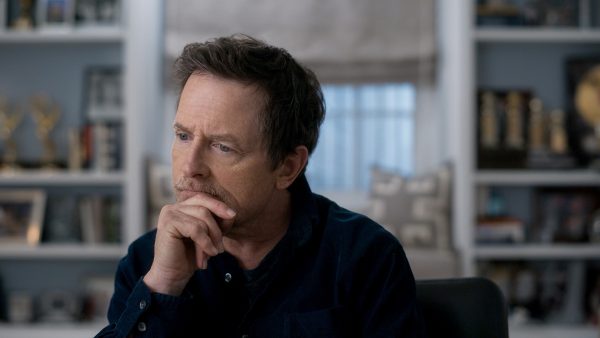
Drawing from Fox’s writings about his life, director Davis Guggenheim’s latest documentary feature tells the title character’s story using an inventive combination of archive footage, interviews with Fox, actor-based re-creations of incidents from his life and footage from his treatment sessions that candidly depict how his condition has progressed. There are also a number of sequences in which Fox’s story is told through fittingly appropriate clips from his movie and TV projects, enhancing the themes that have run through his life and ironically reminding us that art can indeed imitate life. The result is a unique biographical composite that provides an insightful look at one of the entertainment industry’s biggest stars who just happens to be wrestling with issues that extend beyond the boundaries of celebrity.
Michael J. Fox can certainly attest to that. His illness brought him the “teacher” he needed in so many respects. And drawing those circumstances into his life proved valuable in helping him learn the lessons he needed to get. Such are what’s possible through the conscious creation process, the philosophy that maintains we draw on the power of our thoughts, beliefs and intents in manifesting the reality we experience, including the elements needed to teach us valuable life lessons. Fox may not have been aware of this school of thought nor of the timing or form of the teacher that materialized in his life, but its appearance nevertheless helped to bring about the education he needed.
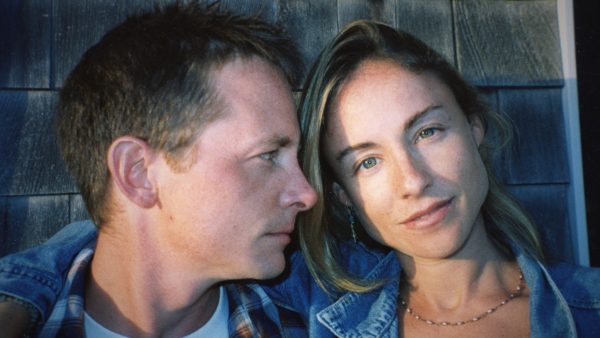
As many of us have discovered, adversity often has a tremendous impact on us. It forces us to slow down and take stock of ourselves and our lives, giving us the time and attention needed to turn introspectively without distraction. And, with such intangible resources available to us during these periods of convalescing – elements that may well not have been available to us previously – we can focus on what we may have heretofore ignored, avoided or not taken the time to address. It can be quite the learning experience, taught by an unlikely teacher.
By his own admission, this was very much the case with Fox. As a child, he had trouble keeping still. And, once his career began to take off, he didn’t have the time to examine this issue. In describing the development of this jam-packed career, he talks about the period when he was simultaneously shooting “Back to the Future” and recording episodes of Family Ties. His days were filled with work on his TV series, and his nights were spent on the movie set, leaving him with little time for virtually anything else. Subsequently, his life was swamped with other projects, having made five movies in three years. And, all throughout this period, he was busy with doing publicity work and interviews to promote these projects. Whatever “free” time he had was spent “relaxing,” which largely consisted of hedonistic pursuits, activities that flew by at almost the same frenzied pace as his work life. This left Fox with little time for introspection and looking into long-ignored life lessons.
Parkinson’s changed all that. It imposed changes on him, some of which Fox was slow to accept. But, with the passage of time, he had to reconcile himself to his new normal. And, gradually, he did so, finally seeing what this experience had to offer him. It may not have been what he was expecting, but it provided him with what he needed.
Ironically, the illness that many would say trapped him ended up liberating him in some very important and meaningful ways. It taught him how to become still. It helped him develop a greater appreciation for spending time with his wife and children. It enabled him to see the gift that life is. But, perhaps most importantly, it provided him with an opportunity to give back through his philanthropic work, most notably through the establishment of his charitable foundation. His celebrity also made it possible for him to draw highly visible attention to his condition, lending credence to such initiatives as his testimony before Congress. And who says there’s nothing good to come out of seeming misfortune? Talk about silver linings.
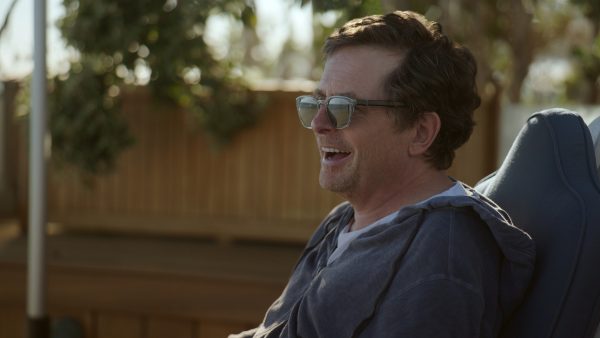
Fox’s journey may have been an unexpected one. And, even though it might have taken him some time to discover the underlying meaning of his circumstances, his experience proved to be a valuable wake-up call. The realizations to come out of it managed to surface and had a profound impact, both on him and on others in the Parkinson’s community. Better late than never.
Director Davis Guggenheim’s latest documentary feature presents viewers with a compelling and touching tale, one that goes beyond the bounds of celebrity and coping with a debilitating disease. It shows us what can come out of conditions like these and the impact it can leave. And it accomplishes these goals in an inventive way through its intriguing mix of elements, content that’s blended seamlessly to drive home its messages. Admittedly, the film has some initial difficulty finding traction to tell its story, but, once past these minor stumbles, it proceeds smoothly, growing ever more insightful and compelling as the narrative plays out. “Still” offers us an honest look into the life of a very public figure who has been fighting a very private battle and the effects that effort has had on shaping and evolving his professional, personal and philanthropic pursuits. Most of all, however, it shows us how we can identify what’s been missing from our lives and take steps to implement it, no matter how unusual the means may be for showing us the way. The film is playing in limited theatrical distribution and is available for streaming online.
Copyright © 2023, by Brent Marchant. All rights reserved.

“Fathers and Mothers” (“Fædre og mødre”) (2022). Cast: Jacob Lohmann, Katrine Greis-Rosenthal, Ida Skelbæk-Knudsen, Victor Madsen, Rasmus Bjerg, Lise Baastrup, Lars Brygmann, Nikolaj Lie Kaas, Line Kruse, Carsten Bjørnlund, Amanda Collin, Martin Greis-Rosenthal, Merete Mærkedahl, Lisa Loven Kongsli, Mikhael Birkkjær. Director: Paprika Steen. Screenplay: Jakob Weis. Web site. Trailer.
Wanting the best for one’s children is a natural tendency for many parents. But how far is one willing to go to see this ambition realized? For some, this takes the form of supportive but restrained encouragement, a healthy approach, to be sure. But what happens when the push for success becomes an obsession, one driven by ever-escalating expectations that put undue pressure on the kids? Add to that the competitive one-upmanship that can emerge in an environment where parents and/or children are pitted against one another to come out on top as the alphas of the pack, and you’ve taken things to an entirely new level. And, if all that weren’t stressful enough, imagine what it might be like for everyone to compete to see who is the most politically correct of the bunch, steering matters to absurd degrees of pseudointellectual perfection. If you can picture that, you’ve got a pretty good idea of what it’s like to attend a private school designed to help students maximize their potential under the constantly hovering guidance of micromanaging adults, as seen in the new Danish satire, “Fathers and Mothers” (“Fædre og mødre”).
Ah, parents these days. They’re not what they used to be. They may operate from a place of good intentions where their children are concerned, but their common sense is often sorely lacking. They frequently imprint their own drive for success on their kids, pushing limits that were never meant to be exceeded with individuals possessing considerably less maturity and life experience. They may also push their purist, extremist ideologies too far with youngsters who are far too ill-equipped to deal with such notions. And, when they decide to let their hair down, they may engage in exercises in reckless abandon that set anything but a good example.

Consider the case of Ulrik (Jacob Lohmann) and his wife, Piv (Katrine Greis-Rosenthal). They’re worried about the social and educational development of their young daughter, Hannah (Ida Skelbæk-Knudsen). They don’t believe she’s making as much progress as she should be, and they attribute this to the schools she’s attended (of which there apparently have been many). To resolve this issue, Ulrik and Piv take a stab at enrolling her in yet another new school, a change for which Hannah demonstrates little enthusiasm. This becomes all too apparent at the family’s interview with the headmaster, Adrian (Lars Brygmann), who is willing to give Hannah a shot as the school’s newest pupil, despite her noticeably underwhelming response.
Ulrik and Piv are thrilled when Hannah is accepted, and they look forward to becoming acquainted with the school’s staff and the parents of the other students. It’s good that they’re so enthusiastic, too, given the expectations that the school requires of them. For example, they’re expected to play an active role in helping to organize and participate in a country getaway weekend for the parents and their children, one of the school’s longstanding traditions and one in which it takes tremendous pride as a time for fun, fellowship and learning. But, before the festivities begin, the school hosts a planning session with all of the parents, an opportunity to share ideas and assignments. It’s also the first chance for Ulrik and Piv to meet their peers.
When the newcomers arrive at the meeting, they’re greeted by a seemingly tight-knit coterie of grinning, wide-eyed zealots who come across more like members of a cult or cast members of a Fellini film than average everyday adults. They joke around and engage in spirited banter, exchanging friendly jabs and inside jokes while seeking to cryptically indoctrinate the initiates. And, even though they appear to have been cut from the same cloth, they all have their own little quirks, penchants and thinly veiled personal issues that they erroneously believe are well camouflaged.
This colorful cadre of cohorts includes, among others:
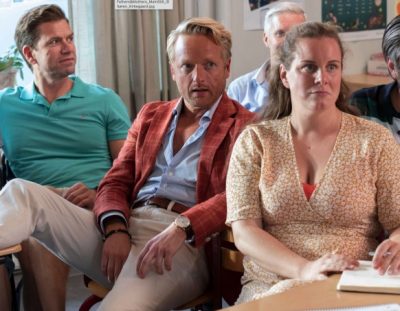
At first glance, the idyllic setting for the weekend getaway would appear to be the perfect spot for everyone to have a lovely, relaxing good time: A well-appointed cabin, a beautiful lakeside location and a generously stocked pantry all carry the promise of a fun-filled escape. However, as events play out through an assortment of activities, challenges and social gatherings, the participants’ true colors gradually come shining through with the brilliance of a thousand suns, as everyone (especially Ulrik and Piv) come to find out. The subtle, nuanced glimpses of their various personas, which became apparent during the organizing meeting, surface here with unrelenting, highly opinionated, sometimes-spiteful force. The parents’ views about how to raise children, live “proper” lives, pursue success, and engage in meaningful, healthy relationships with their partners come flooding forth. And, when they decide to let go and have their own fun, they’re anything but restrained, imbibing to their hearts’ content, participating in questionable behavior and treating the kids almost as if they were afterthoughts. Talk about setting an example.
Through these incidents, everything that the parents claim to have stood for going in to the weekend manages to get lost in a smorgasbord of adults behaving badly, a time filled with volatile arguments, brutal name calling and a host of other nasty episodes. Even the children recognize their parents’ dubious, hypocritical behavior, sometimes pointedly expressing their incisive observations to those they’re supposed to emulate. Then there are the consequences of these unsavory actions, which seriously strain the relationships between the parents and sometimes even between spouses. Indeed, what happened to all of those supposedly well-meaning platitudes that everyone was spouting at the start of the weekend? And what impact will all of this have going forward?
Having and expressing one’s opinions is certainly understandable, but at what point do such practices become undue burdens to others? That’s a crucial consideration in an environment that’s inherently intended to promote such principles as learning, tolerance and understanding. The kinds of intellectual sparring that take place here are more like academic street fights than intelligent, civilized discussions of differing opinions. It’s a form of rhetorical bullying whose aim is more to browbeat others into submission than to win over someone’s agreement through reasoned discourse. Is that really the best way to put one’s beliefs to use, especially in dealings with peers?

While it’s true that a firm conviction for one’s beliefs can help to bring about desired results, that dynamic can change when such views become obsessive or fanatical. There’s an underlying component of desperation involved that taints the fundamental intent, a belief that one’s views must be conveyed and embraced by others at all costs. And, when that’s the case, how likely are others to agreeably respond to such coercion? Not only can this foster conflict among peers who disagree, but it can also potentially inflict harm on those who lack sufficient maturity, sophistication and life experience to defend themselves or fight back – case in point, the children of the parents in this film. This kind of self-importance ultimately leads to pushing too hard, a lack of perspective and perhaps even shunning by others if carried too far. In those cases, having the last word really can end up being the last word.
All of this can become exacerbated when such views are dispensed with insincerity and hypocrisy, as is often seen in this film. The use of such devices may seem like a good way to enhance one’s persuasiveness, but it can seriously backfire. If one were to try sugarcoating ideas that may be otherwise challenging to impart, astute observers might readily see through the artifice, exposing the lip service and revealing the proponent’s true colors. How embarrassing that would be when the man behind the curtain is exposed?
Several scenarios in the film reflect these notions, unmasking hypocrites who deceitfully profess to be enlightened, tolerant and inclusive. For example, despite their supposed open-mindedness to the school accepting students from a variety of backgrounds, several parents look down upon the enrollment of a troubled young man, Julian (Victor Madsen), placed by social services. They worry about this potential “bad influence” and the effect he might have on the remainder of the student body. Even Ulrik and Piv are somewhat hesitant about his presence, especially when Hannah begins taking a liking to Julian, a bond forged by their mutual feelings of being disrespected by the adults.
Similar conditions are present among the parents, too. Per, for example, is proud of his weight loss success, a development that’s met with behind-his-back snickering and condescending congratulations. And those who aren’t quite so disingenuous are more direct in their criticism, questioning the extent of Per’s success and even going so far as to grill him on how he gained so much weight in the first place. In all of these cases, the holders of these beliefs obviously adhere to their views, and they’re certainly entitled to do so. But, in an environment in which providing support and encouragement to others is supposedly a significant value, aren’t such notions incongruous and/or inappropriate? If these parents can’t advocate for their peers in the face of challenges like this, how realistic is it that they can effectively do the same for their kids? That could be an overstatement, but it’s a question that potentially might have some validity, an important consideration where the hope of tomorrow is concerned.

The bottom line in all this is that those who claim to be so supremely enlightened need to take a good, hard look at themselves and the beliefs they embrace. Given the power and persistence of these resources, their impact could be considerable, especially on those who might be easily affected or influenced (i.e., their peers and children). Sharing a wealth of opinions within a group can be a healthy practice as long as those views are presented with a sense of perspective and civility. But, if allowed to be used as intellectual cudgels to get one’s point across, they truly become the weapons they appear to be, and no one benefits from that – including those wielding them.
Director Paprika Steen’s latest offering presents a wickedly funny take on those who allegedly operate from a standpoint of seemingly good intentions but end up competing with one another to be the best über-moms and dads possible, particularly when it comes to showing off their degrees of social consciousness and political correctness. In the process, they ostensibly engage in toxic games of one-upmanship, strategic posing that eventually descends into bitter arguments that violate their so-called principles. Indeed, such bad behavior makes anything untoward that their kids do appear tame by comparison. Some viewers may look upon this as mean-spirited, but its observations are spot-on when it comes to poignantly portraying the hypocrisy of those who believe that their you-know-what doesn’t stink. And this all comes out loud and clear in the picture’s superb writing.
Given the multiple characters and story threads at work here, the film can be somewhat episodic at times, and a few of the narrative tracks don’t feel fleshed out as fully as they might have been. Nevertheless, this offering paints an authentic picture with its share of incisive dramatic moments, as well as ample biting humor that’s depicted directly, by implication and even in deftly placed visuals. When viewed in this context, it’s apparent that there’s a lot more going on here than may superficially meet the eye. There’s a great deal of insightful material tightly packed into this package, but it mostly involves things that need to be said – and, ultimately, in ways that are very much in your face. Let’s hope that those who need to get the film’s message indeed do considering what’s at stake.
Unfortunately, finding this release may take some effort at the moment, as it has primarily been playing the film festival circuit. However, this is a worthwhile view, especially with the growing discontent that has been developing among those who have tired of extremist political correctness. We can only hope that “Fathers and Mothers” lands a theatrical and/or streaming distribution deal, as it truly deserves it.
A vintage 1980s PSA about the dangers of child abuse boldly maintained that “Words hit as hard as a fist.” And, as this film shows, the same can be said for beliefs and what can spring forth from them. It’s not just children who are affected by this, too. In light of that, given the fallout that can arise from such circumstances, it would behoove us to be careful with this practice. We wouldn’t want to be party to the kind of bad behavior on display here, especially given the potential boomerang effect that can accompany it, both for ourselves and our posterity.
Copyright © 2023, by Brent Marchant. All rights reserved.

“Slava Ukraini” (“Glory to Ukraine”) (2023). Cast: Bernard-Henri Lévy. Director: Bernard-Henri Lévy. Screenplay: Bernard-Henri Lévy. Web site. Trailer.
As a sequel to a previous work, “Why Ukraine?,” which was created for European television, this latest effort seeks to dive deeper into what has been transpiring in the war-torn nation since the conflict’s onset in February 2022. Told as a sort of travelogue through the nation’s various hot spots, including many on the front lines, Lévy chronicles what has happened across Ukraine from the start of the war, oftentimes brought down to a touching, intimately personal level. We witness the pain that the country’s citizens have endured through the brutal, often-relentless Russian attacks. But we also see the utter joy and relief that many have also experienced as a result of the liberation of many areas once held by the enemies brought about by tenacious Ukrainian forces determined to maintain their sovereignty and take their nation back. Such moments frequently prove bittersweet, though, particularly when the liberated are still uncertain about the fates of loved ones who were caught up in the fighting on the way to the restoration of their freedom. There’s hope in these developments, though nevertheless tinged with sadness and doubt.
The filmmaker’s journey begins in Ukraine’s capital, Kyiv, which he contends has more or less returned to “normal,” save for the rubble of bombed-out buildings and the occasional air raid sirens, thanks to troop initiatives that have kept Russian forces at bay, often prompting hasty retreats and desertions by the invaders. From there he travels across Ukraine, visiting various large and small communities, many of which have also been reclaimed. He even ventures into the contentious Donbas region of eastern Ukraine, home to many ethnic Russians, where the area’s residents have been embroiled in conflict, often with interference from across the border, for nearly a decade. This region’s communities were among the first to fall into Russian hands when the current war began, but even many of them have now been retaken by Ukrainian forces, in many cases without much resistance.
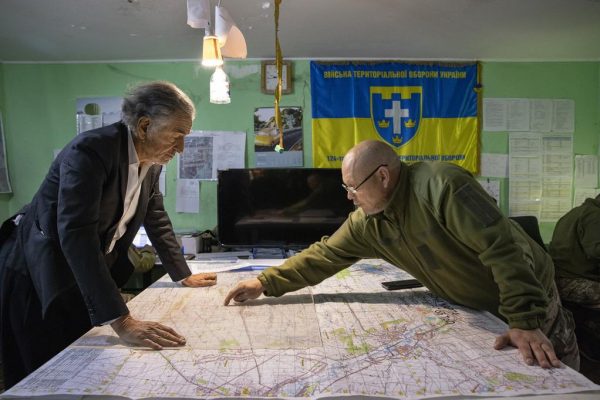
Following these travels, the film crew returned to Kyiv before heading south to the Oblast region, home to the warm water ports of Odesa and Kherson on the Black Sea, both of which came under attack by Russian forces because of their strategic nature and were still considered hot spots at the time of filming in November 2022. However, by the time of the crew’s arrival in the area, both cities were in Ukrainian hands, despite periodic bombardments of infrastructural targets by Russian missiles and the positioning of snipers across the Dnieper River, which runs through Kherson. Such measures were looked upon as scorched earth initiatives, designed more than anything else to harass and inconvenience in retreat, but they were nevertheless dangerous, as the filmmaker found out when he and his crew were hurriedly shepherded out of harm’s way when they came within the snipers’ sights.
The crew’s filmed escape from the snipers illustrates one of the key elements characterizing this picture – its content was all real, no editing, staging or alteration of any kind, a genuine, firsthand chronicle of what actually happened to Lévy and his production team while on their visit to Ukraine. The compilation of this footage thus calls to mind the work of US television crews that were present on the ground to film what happened during the Vietnam War. While this film didn’t capture as much battlefield footage as what happened in Vietnam, there are segments that illustrate the bona fide threats that the filmmaker and his staff faced while compiling their account of this all-too-real story.
Perhaps the most pertinent theme that runs through this documentary is its depiction of the unparalleled (and much publicized) sense of unity among the Ukrainian people in battling this ordeal. What’s unique here, however, is the way that this is illustrated through the film. The solidarity of Ukraine’s citizens is so pervasive that it touches virtually every element of society, with everyone working concertedly in tandem, each doing his or her part in their respective milieus to help ensure victory. They truly understand the bigger picture at play here, and they give their all to execute their various tasks to see its goals fulfilled.

The director organically captures the stories of those involved in this effort. There are, of course, numerous accounts of soldiers and sailors diligently carrying out their missions with courage and precision. Then there are the stories of everyday citizens doing everything from collecting, assembling and distributing food and supplies to those affected by the conflict to the caregivers watching over the children to see that they’re protected and still receiving an education, even during a time of war. The roles of laborers are not overlooked, either, such as the workers at a former Soviet steel mill who are processing product necessary for carrying out the war effort. This even includes the country’s coal miners, who continue to extract this precious resource to fuel the mill’s blast furnaces. Indeed, everyone has a role to play in this immense undertaking, and the film brings them all to light.
The film also makes a point of highlighting the part that foreigners are playing in this conflict. While it’s well known that Ukraine has been receiving ample international assistance from the West in terms of weapons and supplies, the country has also been benefitting from the direct involvement of foreign nationals in country on the ground. Soldiers-for-hire from 32 nations have been participating in the war, as exemplified in an interview with a French infantryman who volunteered to fight, not only because he saw it as the right thing to do, but also because he has a personal vested interest: to help find and protect his Ukrainian wife and family, whose fate at the time of filming was unknown.
Of course, perhaps the most important foreign national in this story is the filmmaker himself, French writer-director-philosopher Bernard-Henri Lévy. His humanitarian activism in Ukraine dates back to the 2014 Maidan Revolution, when the country’s citizens clashed over the future direction of the nation – one with closer ties to the European Union or the continuation of its affiliation with Vladimir Putin and the Russian Federation. Lévy saw the handwriting on the wall if Russian influences were to be allowed to continue unabated, jeopardizing Ukrainian freedoms and its desire to align itself more with the West. And, as the tensions escalated in the time since then, he has made it one of his goals to draw attention to the situation and what it could mean, not just for Ukraine, but also for the West in general.

I had the pleasure of seeing this film at a special screening featuring the director in person for a Q&A session after the picture. In that session, he discussed some of his activist efforts, many of which weren’t covered in the film. For example, he noted that the proceeds from the film will be donated to charitable organizations assisting in the war effort. Moreover, Lévy added, in shooting the picture, he and his colleagues amassed roughly 200 hours of footage (which, remarkably, was pared down to an economical and well-organized runtime of 1:35:00). Amongst the unused footage he shot were the stories of many Ukrainian citizens who suffered tragic losses at the hands of the Russians, material that he is convinced could be used as visual testimony in war crimes trials when they come to pass (not if they come to pass) in what he foresees as a certain victory over the invaders, especially given the unified spirit of the nation’s citizens and the way in which the conflict has been progressing. Now that’s commitment.
In telling the stories of the Ukrainian nationals who he interviewed for the film, the director narrates these tales by drawing from his own philosophical background, presenting them with a poetic touch (which, admittedly, can get a bit flowery at times but is nevertheless quite admirable for taking a decidedly different approach to this material). He waxes expressively in speaking about what has happened to Ukraine’s citizens, none of whom asked for any of what has happened to them. Simultaneously, he draws from the history of previous international conflicts, such as the Spanish Civil War and World War II, to draw parallels between those events and what has happened in this engagement. For instance, Lévy compares Putin’s ill-timed, poorly considered invasion of Ukraine to that Adolph of Hitler’s invasion of Russia during World War II, proving once again that those who don’t learn from history are doomed to repeat it.
When all of these factors are taken together, “Slava Ukraini” paints a comprehensive, inspiring picture of a people who are willing to do whatever it takes to overcome the atrocities that have been inflicted upon them. To the Ukrainians, the question of reaffirming their sovereignty has itself never been a question to begin with, and this documentary brings that notion front and center. And Lévy doesn’t deny that this is, by its nature, a partisan film. But, in making the case for this nation and its citizens, he has put forth an important picture that anyone who truly believes in the preservation of freedom and democracy should see (and tell others about). There’s more at stake here than just one nation’s autonomy. The people of Ukraine understand that, and it’s time the rest of us did as well.
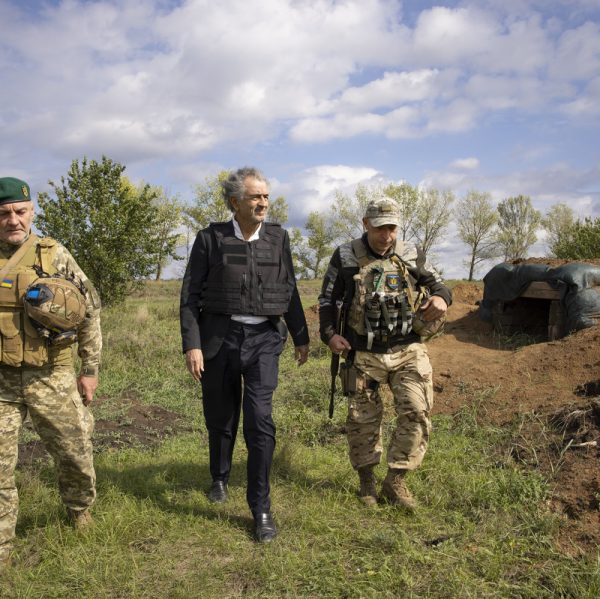
This is particularly true in light of the views held by the Russians, who have been abandoning their posts in droves. This is apparent in the huge numbers of invading troops who have simply walked away from their assigned tasks, despite whatever consequences they might face. This is also evidenced by the success of a Ukrainian program that has enabled Russian soldiers to safely defect by calling a special hotline in which the foreign troops can arrange to meet with their opponents to be escorted out of danger and retribution from their own commanders.
So why has this been happening? According to Lévy, it’s because the Russians don’t believe in the supposed cause they’ve been coerced into fighting for. They don’t see the purpose, so they can’t get behind it, and this, coupled with the focused tenacity of the Ukrainians, has led to the Russians’ demoralized attitude, sagging support and declining success on the battlefield. And who says our beliefs don’t create our reality?
The Ukrainians’ efforts have been further bolstered by beliefs in specific areas, notions designed to enhance their basic will for success. For instance, as events have unfolded, it’s become obvious that the Ukrainians have tremendous faith in their convictions, a belief that they’re certain about the justness of their cause, a powerful add-on to the convictions supporting their basic intents. Likewise, as the film illustrates, the Ukrainians have been inventive in their approach to this venture, such as the aforementioned hotline. They have successfully made use of whatever is available to them to carry on the fight, including in undertakings not directly related to combat (such as improvised infrastructural and transportation systems), even if these solutions are anything but conventional. This represents a pronounced willingness to think outside the box, to draw upon beliefs in such areas as innovation and resourcefulness that set aside any fears, doubts or limitations that might otherwise hinder their efforts. These may seem like small and simple steps in themselves, but, when combined with the Ukrainians’ other beliefs, they add up to quite a lot. Indeed, who in their right mind would want to take on an opponent with an arsenal of intent like that?
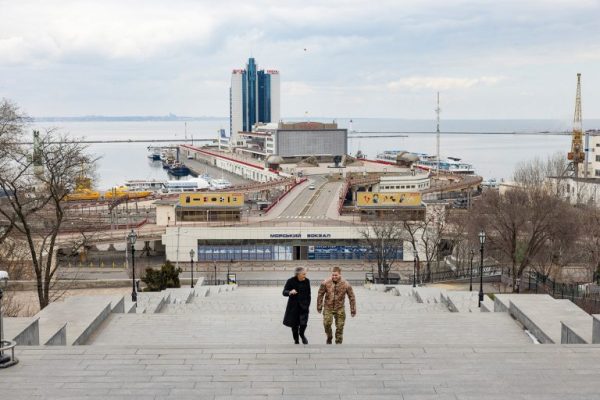
Most importantly, though, the Ukrainians have embraced a belief that victory is theirs to be had in the end. It may take some time to reach that point, and there may be more setbacks along the way. But the outcome, in their minds, has already been determined, a result that Lévy shares as well. In fact, as noted above, sharing that notion widely is one of the main reasons he made this film. Given Ukraine’s geography, situated squarely between Russia and Western Europe, the nation is seen as a transitionary bridge between these two opposing forces, and the war is as much about protecting the West against Putin’s aggression as it is about protecting the country’s sovereignty. The Ukrainians understand that, and they want their Western allies to grasp this, too. That’s why those who live outside its borders should care about – and believe in – the importance of their victory as well.
“Slava Ukraini” may not fit the standard documentary mold (especially in its eloquent voiceovers), but it nevertheless enlightens us to a far greater degree than many other films about this conflict, not to mention the subject of warfare in general. Admittedly, there is some footage that sensitive viewers might find disturbing, so those prospective audience members should take this into consideration when making a screening decision. However, in light of what this film has to offer, I’d be curious to see what else the director captured in the other 198 hours of filming that didn’t make the final cut. “Glory to Ukraine” provides valuable insight into an event that has the potential to leave a significant and long-lasting impact not just on the residents of Ukraine and its neighbors but on the totality of humanity as well. And, if a spry 70+-year-old can take up the cause to bring this story to the public’s awareness, the least we can do is watch and spread the word about it. The film is available for screening in limited theatrical release and can be found online from multiple streaming platforms.
Copyright © 2023, by Brent Marchant. All rights reserved.